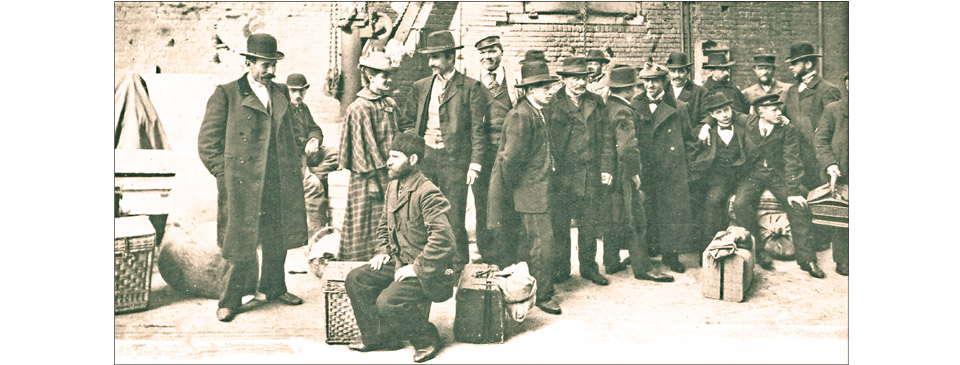The German Community in London during the 19th century

Germans arriving by steamer at the London docks in the end of the 19th century. Some would have stayed in Britain while others made the onward journey to North America.
Until the great wave of Jewish immigrants, the largest group of foreigners in London during the 19th century were Germans. It was estimated that at a certain point they accounted for six-sevenths of foreigners in the metropolis. They ranged from the very wealthy to the destitute, with many of them carrying out the toughest of manual labour. The German community grew over many decades, reaching a peak in the early 20th century.
When the Elector of Hanover arrived as King George I of Great Britain and Ireland in 1714 he brought with him German bureaucrats, bankers, merchants, scholars, artists and doctors. The majority who followed during the 19th century were economic migrants, with many from an agricultural background, leaving their homeland due to poverty. At the other end of the scale there were businessmen, such as Karl Wilhelm Siemens who established a London branch of the Berlin firm, and those who founded the Schröders and Kleinwort banks. Britain was then a more liberal country than Germany, with greater freedom of speech, so there were amongst them some political refugees, such as Karl Marx.
Steamers from Bremen and Hamburg docked at the St. Katharine docks or at Thames wharves, bringing new arrivals. Some hoped to make an onward journey to America to where three million Germans emigrated between 1855 and 1890. They needed to transfer to larger ships for the Atlantic crossing than those that crossed the North Sea. Some took temporary work to pay for their onward voyage and others remained in London.
Middle-class men came to find work or to advance their business interests. They usually arrived equipped with a German-English conversation book, as well as a map to find their way around. Germany had a strong tradition of technical schools for professionals, so waiters and clerks could easily find employment in London. Some came to study the British way of life and increase their knowledge and skills. They would no doubt head for Fitzrovia, where middle class and professional Germans resided, or to Kentish Town, Camden or Islington. Young women, covered in woollen shawls, came seeking employment as domestic servants, nurses and governesses.
The poorer sort of Germans remained in East London, close to the docks. Whitechapel, St. George-in-the-East, and Mile End Old Town were the main districts where they settled. This area, roughly rectangular in shape and bounded approximately by Whitechapel Road, Leman Street, the Highway (formerly St. George Street) and New Road/Cannon Street Road, was sometimes known as ‘Little Germany’. In that area they mixed with Jewish immigrants from Eastern Europe. German and Jewish names were over the doors of shops selling all kinds of merchandise and services: butchers, grocers, fruiterers, confectioners, boot-makers, tailors, publicans, drapers and cigar-makers. Thousands of German working men and women crowded into tenements. Poor workers unable to rent their own accommodation could take a bed in a Handwerker Heim. As well as somewhere to sleep, these hostels offered meals, lectures and religious teaching, books and periodicals.
Throughout London, German restaurants offered Kraftiger Mittag- und Abend-tish (a full lunch or dinner) for a modest price, as low as four pence (less than two modern pence). Well-patronised German public houses offered skittles. For those who could afford it, there were German clubs and societies, particularly around Charlotte Street and Fitzroy Street, for sports and gymnastics, cycling, dancing, concerts, drama, dining, games, English lessons and technical training. A survivor of that era is the German Gymnasium at Kings Cross, now a smart restaurant and bar. At regular dinners at their clubs, which were decorated with flags and garlands and a bust of their king, patriotic Germans raised a toast to Kaiser Wilhelm.
There was a strong religious element amongst the community, with the majority of them being Lutheran. There were three German churches, all located within a few hundred yards of each other. The St. Georgeskirche (St. George’s church) was opened in 1763 in Little Alie Street, off Leman Street, and remains on the same site today. St. Paul’s Evangelical Reformed Church was founded in the City during the late 17th century by a congregation that had fled religious persecution in the Palatinate. Baron Schröder laid the foundation stone when the church was rebuilt on a new site at Whitechapel. Similarly, St. Bonifatius Roman Catholic church was founded in the City before moving to Whitechapel. Ironically, the latter two churches were destroyed by German bombing during the Second World War although St. Bonifatius was rebuilt and reopened in 1960.
The King of Prussia, the Austrian Emperor, Queen Victoria and her German husband Albert, and other wealthy Germans financed a German hospital at Dalston, which opened in 1845. The area was still quite rural at that time, with a reputation as a healthy place. It became a well-respected institution and by the end of the century contained over 120 beds. The hospital also operated dispensaries in East and West London, as well as orphanages and old peoples’ homes. The building remains on the same site, although no longer a hospital.


